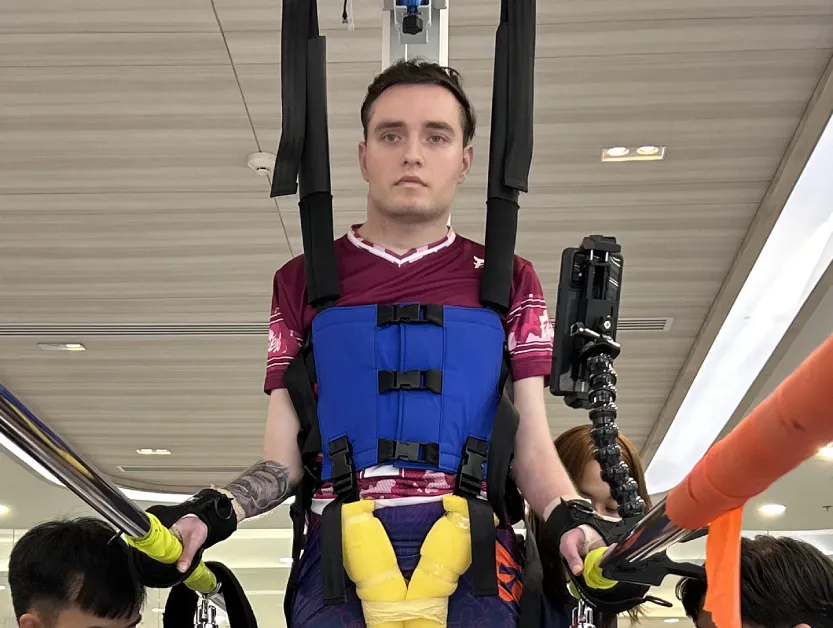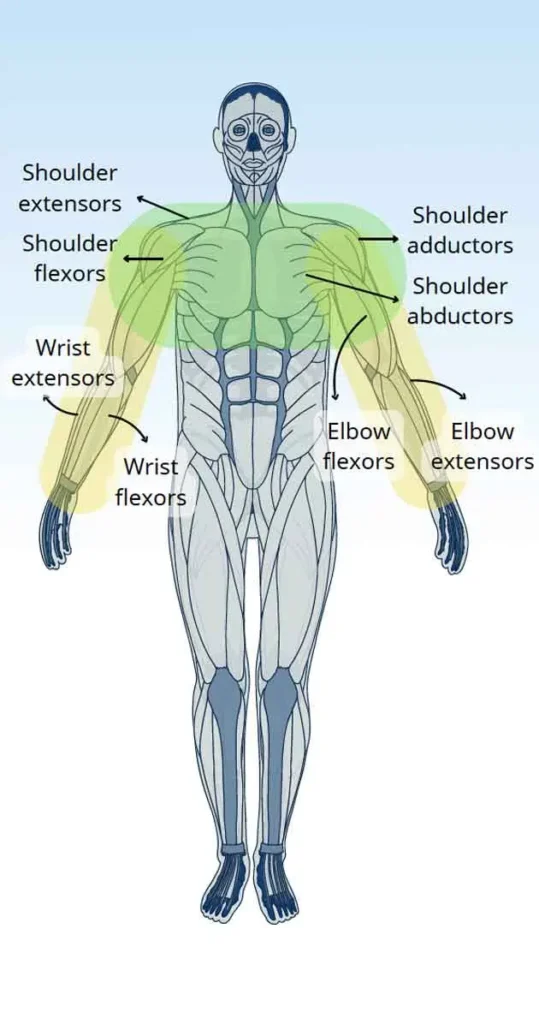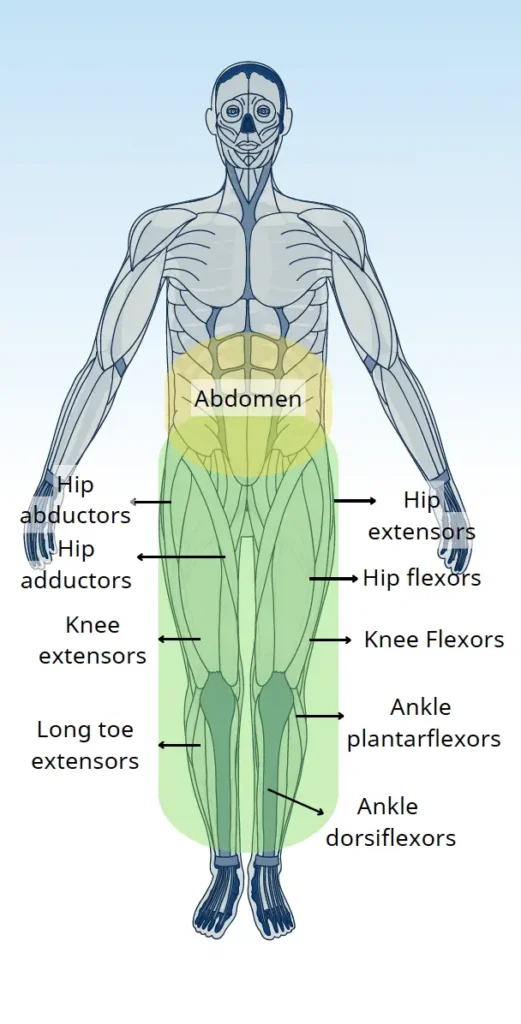Nikita
- Spinal Cord Injury (SCI),
- C4, Complete
Epidural Stimulation

| Implantation site | Number of devices | Duration of stay |
|---|---|---|
| Cervical spinal cord | 1 | Extended stay for neurorehabilitation |
| Lumbar spinal cord | 1 | Extended stay for neurorehabilitation |
| Post-surgical care | Total sessions | Session per week | Time (Hr.) per session |
|---|---|---|---|
| Physical Therapy & Lower Extremity Mapping | 129 | 17 | 1 |
| Occupational Therapy & Upper Extremity Mapping | 86 | 12 | 1 |
| Total Sessions of Rehabilitation | 215 |

| Muscle improvement | Before Epidural Stimulation surgery | At discharge (50 Days after admission) | 1 year after discharge | 2 years after discharge |
|---|---|---|---|---|
| Shoulder flexors | 1+ | 2 | 2+ | 3 |
| Shoulder extensors | 1 | 2 | 3 | 4 |
| Shoulder abductors | 1+ | 2 | 3 | 3+ |
| Shoulder horizontal abductors | 1 | 2 | 3 | 3 |
| Shoulder adductors | 2 | 3 | 3 | 3 |
| Shoulder horizontal adductors | 1 | 2 | 3 | 3+ |
| Elbow flexors | 3 | 4 | 5 | 5 |
| Elbow extensors | 2 | 2+ | 3 | 3 |
| Wrist flexors | 0 | 1 | 1 | 1 |
| Wrist extensors | 0 | 1 | 1 | 1 |
| Finger flexors | 0 | 3 | 3 | 3 |
| Finger extensors | 0 | 0 | 1 | 1 |

| Muscle improvement | Before Epidural Stimulation surgery | At discharge (50 days after admission) | 1 year after discharge | 2 years after discharge |
|---|---|---|---|---|
| Hip flexors | 0 | 2 | 3 | 3 |
| Hip extensors | 0 | 1 | 2 | 2 |
| Hip abductors | 0 | 1 | 2 | 2 |
| Hip adductors | 0 | 1 | 2 | 2 |
| Knee extensors | 0 | 1 | 2 | 2 |
| Knee flexors | 0 | 2 | 3 | 3 |
| Ankle dorsiflexors | 0 | 2 | 3 | 3 |
| Ankle plantarflexors | 0 | 2 | 2 | 2 |
| Long toe extensors | 0 | 1 | 2 | 2 |
| Abilities & Symptoms | Before Epidural Stimulation surgery | At discharge (50 days after admission) | 1 year after discharge | 2 years after discharge |
|---|---|---|---|---|
| Feeding | Not possible | Improved (hold large handle but cannot bring to mouth) | No change | Improved (hold large handle and bring to mouth stably) |
| Grooming (Personal hygienic care) | Not possible | Not possible | Improved (hold large handle/ electric toothbrush) | No change |
| Dressing | Not possible | Not possible | Improved (able to reach arms to help caregiver) | No change |
| Writing | Not possible | Not possible | Not possible | Not possible |
| Grasping | Not possible | Improved (squeeze, hold, pinch and grasp object) | No change | No change |
| Wheelchair control (Hand controlled wheelchair) | Not possible | Improved (controlled by himself for short distance) | Improved (controlled by himself outdoor) | Improved (controlled by himself in general) |
| Standing with support | Absent* | Poor* | Fair* (with moderate assistance) | Fair* (with moderate assistance) |
| Stepping with support | Absent* | Poor* | Fair* | Fair* |
| Standing balance | Absent* | Poor* | Fair* | Fair* |
| Sitting balance | Poor* | Poor* | Fair* | Fair* |
| Motor coordination (while walking) | Absent* | Poor* (both legs jump up together) | Fair* | Fair* |
| Sit to stand (in parallel bar) | Maximum assistance | Maximum assistance | Maximum assistance | Maximum assistance |
| Ability to transfer | Absent* | Absent* | Absent* | Absent* |
| Ability to use abdominal muscles during bowel program | Absent* | Poor* | Poor to fair* | Poor to fair* |
| Stamina & Fatigue | Poor endurance | Fair endurance | Fair to good endurance | Fair to good endurance |
| Spasticity | Minimal | Minimal | Moderate Spasticity (Increased) | Moderate Spasticity (Decreased by programs) |
| Abilities & Symptoms | Before Epidural Stimulation surgery | At discharge (50 days after admission) | 1 year after discharge | 2 years after discharge |
|---|---|---|---|---|
| Neuropathic pain | Absent * | Increased (slightly) | Increased (severe) | Decreased (by programs) |
| Temperature sensations | Absent * | No change | Poor * | No change |
| Proprioception | Absent * | Poor * | No change | No change |
| Bladder sensation | Absent * | Poor * | Fair * | No change |
| Bowel sensation | Absent * | Poor * | No change | Poor to Fair * |
| Abilities & Symptoms | Before Epidural Stimulation surgery | At discharge (50 days after admission) | 1 year after discharge | 2 years after discharge |
|---|---|---|---|---|
| Sweating ability | Absent * | Improved (slightly sweating) | Improved (sweating during exercise) | Improved (upper body sweating during exercise) |
| Temperature regulation | Absent * | Poor * | No change | Poor to Fair * |
| Blood pressure regulation | Stable | Stable | Stable | Stable |
There had been remarkable recovery in Nikita’s motor functions, his sitting and standing balance, and fine and gross motor skills. Nikita is now able to stand and walk with the help of upper body support, has an improved sitting and standing balance and regained visible movements back in his arms, wrist and finger function.
Nikita reported persistent improvements in his sensory functions including better proprioception and temperature sensations below the level of injury. He is able to locate his limbs in space and time when walking.
His body temperature and blood pressure regulation improved after the treatment. He is now able to sweat more and does not have any major fluctuations in his blood pressure levels or any significant drop while standing and walking.
Nikita now has a better trunk stability and improved sitting balance. He is able to hold his body without any back support even when challenged by sideway movements.
Nikita’s standing function and postural stability has improved remarkably since he started his treatment.
Nikita sustained a traumatic spinal cord injury and was diagnosed with traumatic spinal cord at C4 with very minimal and nonfunctional motor function in his shoulders. He went through the standard physical therapy in Israel for one and half years before heading to Verita Neuro in Thailand.
Upon arrival he received extensive check-up and MRI scan after which he was confirmed as a candidate for cervical and lumbar epidural stimulation surgeries. The surgery and post operative course went well without any adverse events and after 2 days break Nikita started the mapping process. We were able to see muscle contractions as soon as the stimulator was turned on and slowly we were able to restore the muscle movements in major muscle groups. This has been improving gradually since then.
Overall there had been visible improvements in all of the affected areas which included motor functions, sensory functions and autonomic functions. Nikita is now able to stand and walk and have an improved upper body function. His sensory functions as well as autonomic functions has improved. His stamina and fatigue levels, his muscles mass and strength, as well as his general wellbeing have improved.
We use cookies on our website to give you the most relevant experience by remembering your preferences and repeat visits. By clicking “Accept All”, you consent to the use of ALL the cookies. However, you may visit "Cookie Settings" to provide a controlled consent.